Quantifying Food Waste in the Hospitality Sector and Exploring Its Underlying Reasons—A Case Study of Lahore, Pakistan
Abstract
:1. Introduction
2. Materials and Methods
2.1. Scope and System Boundary
2.2. Sampling Strategy
2.3. Key Performance Indicators (KPIs): Waste per Customer and Percentage of Waste
2.3.1. Calculating “Waste per Customer”
2.3.2. Calculating “Percentage Waste”
3. Results
3.1. Key Performance Indicators
3.2. Sources/Processes of Food Waste
3.3. Food Waste Segregation and Tracking
3.4. Food Waste Redistribution and Recovery
4. Discussion
Limitations and Uncertainties
5. Conclusions
Supplementary Materials
Author Contributions
Funding
Institutional Review Board Statement
Informed Consent Statement
Data Availability Statement
Conflicts of Interest
References
- WWF-UK. Driven To Waste: The Global Impact of Food Loss and Waste on Farms. Available online: https://wwf.panda.org/discover/our_focus/food_practice/food_loss_and_waste/driven_to_waste_global_food_loss_on_farms/ (accessed on 30 November 2021).
- Gustavsson, J.; Cederberg, C.; Sonesson, U. Global Food Losses and Food Waste; FAO: Rome, Italy, 2011. [Google Scholar]
- Malefors, C.; Callewaert, P.; Hansson, P.-A.; Hartikainen, H.; Pietiläinen, O.; Strid, I.; Strotmann, C.; Eriksson, M. Towards a Baseline for Food-Waste Quantification in the Hospitality Sector—Quantities and Data Processing Criteria. Sustainability 2019, 11, 3541. [Google Scholar] [CrossRef] [Green Version]
- Silvennoinen, K.; Heikkilä, L.; Katajajuuri, J.-M.; Reinikainen, A. Food waste volume and origin: Case studies in the Finnish food service sector. Waste Manag. 2015, 46, 140–145. [Google Scholar] [CrossRef] [PubMed]
- Dou, Z.; Wang, Y.; Ying, H.; Darko, S.; Chen, T.; Tian, X.; Zheng, H.; Li, Y.; Fan, S.; Cui, Z. Reducing Food’s Resource and Climate Footprints Via Food Waste Upcycling; Research Square: Durham, NC, USA, 2022. [Google Scholar]
- Baig, M.B.; Al-Zahrani, K.H.; Schneider, F.; Straquadine, G.S.; Mourad, M. Food waste posing a serious threat to sustainability in the Kingdom of Saudi Arabia—A systematic review. Saudi J. Biol. Sci. 2019, 26, 1743–1752. [Google Scholar] [CrossRef] [PubMed]
- FAO. Food Wastage Footprint & Climate Change Global Food Loss and Waste; FAO: Rome, Italy, 2021. [Google Scholar]
- Afzal, N.; Afionis, S.; Stringer, L.; Favretto, N.; Sakai, M.; Sakai, P. Benefits and Trade-Offs of Smallholder Sweet Potato Cultivation as a Pathway toward Achieving the Sustainable Development Goals. Sustainability 2021, 13, 552. [Google Scholar] [CrossRef]
- FAO. Methodological Proposal for Monitoring SDG Target 12.3.1 Sub-Indicator 12.3.1.A; FAO: Rome, Italy, 2019. [Google Scholar]
- Linh, N.K. Food waste management in the hospitality industry Case study: Clarion Hotel Helsinki. Bachelor’s Thesis, University of Applied Sciences, Helsinki, Finland, 2018. [Google Scholar]
- FAO. Global Food Losses and Food Waste—Extent, Causes and Prevention; FAO: Rome, Italy, 2011. [Google Scholar]
- FUSIONS. Drivers of Current Food Waste Generation, Threats of Future Increase and Opportunities for Reduction; FUSIONS: Bologna, Italy, 2014. [Google Scholar]
- Vittuari, M.; Azzurro, P.; Gaiani, S.; Gheoldus, M.; Burgos, S.; Aramyan, L.; Valeeva, N.; Rogers, D.; Östergren, K.; Timmermans, T.; et al. Recommendations and Guidelines for a Common European Food Waste Policy Framework; FUSIONS: Bologna, Italy, 2016. [Google Scholar] [CrossRef] [Green Version]
- Papargyropoulou, E.; Steinberger, J.K.; Wright, N.; Lozano, R.; Padfield, R.; Ujang, Z. Patterns and Causes of Food Waste in the Hospitality and Food Service Sector: Food Waste Prevention Insights from Malaysia. Sustainability 2019, 11, 6016. [Google Scholar] [CrossRef] [Green Version]
- Aamir, M.; Ahmad, R.; Javaid, Q.; Hasan, S.M. Waste Not, Want Not: A Case Study on Food Waste in Restaurants of Lahore, Pakistan. J. Food Prod. Mark. 2018, 24, 591–610. [Google Scholar] [CrossRef]
- Tostivint, C.; De Veron, S.; Jan, O.; Lanctuit, H.; Hutton, Z.V.; Loubière, M. Measuring food waste in a dairy supply chain in Pakistan. J. Clean. Prod. 2017, 145, 221–231. [Google Scholar] [CrossRef]
- Khalid, S.; Naseer, A.; Shahid, M.; Shah, G.M.; Ullah, M.I.; Waqar, A.; Abbas, T.; Imran, M.; Rehman, F. Assessment of nutritional loss with food waste and factors governing this waste at household level in Pakistan. J. Clean. Prod. 2018, 206, 1015–1024. [Google Scholar] [CrossRef]
- Akram, W.; Javed, I. Food wastage and implications for food safety with special reference to marriage ceremonies. Int. J. Agric. Ext. 2021, 9, 201–2015. [Google Scholar] [CrossRef]
- Xue, L.; Gang, L. Introduction to global food losses and food waste. In Saving Food; Academic Press: Cambridge, MA, USA, 2019; pp. 1–31. [Google Scholar]
- United Nations Environment Programme. Food Waste Index Report 2021; United Nations: Nairobi, Kenya, 2021. [Google Scholar]
- Dhir, A.; Talwar, S.; Kaur, P.; Malibari, A. Food waste in hospitality and food services: A systematic literature review and framework development approach. J. Clean. Prod. 2020, 270, 122861. [Google Scholar] [CrossRef]
- Lorenz, B.A.; Hartmann, M.; Hirsch, S.; Kanz, O.; Langen, N. Determinants of Plate Leftovers in One German Catering Company. Sustainability 2017, 9, 807. [Google Scholar] [CrossRef] [Green Version]
- Wang, L.; Xue, L.; Li, Y.; Liu, X.; Cheng, S.; Liu, G. Horeca food waste and its ecological footprint in Lhasa, Tibet, China. Resour. Conserv. Recycl. 2018, 136, 1–8. [Google Scholar] [CrossRef]
- Tostivint, C.; Östergren, K.; Quested, T.; Soethoudt, J.M.; Stenmarck, A.; Svanes, E.; O’Connor, C. Food Waste Quanti-Fication Manual to Monitor Food Waste Amounts and Progression; BIO by Deloitte: Paris, France, 2016. [Google Scholar]
- UNICEF Pakistan. National Nutrition Survey 2018—Key Findings Report; UNICEF: Lahore, Pakistan, 2018. [Google Scholar]
- Imteaz, A. Follow up on food waste quantification in Swedish public catering. Master’s Thesis, Swedish University of Agricultural Sciences, Uppsala, Sweden, 2022. [Google Scholar]
- Spring, C.A.; Biddulph, R. Capturing Waste or Capturing Innovation? Comparing Self-Organising Potentials of Surplus Food Redistribution Initiatives to Prevent Food Waste. Sustainability 2020, 12, 4252. [Google Scholar] [CrossRef]
- Eriksson, M.; Strid, I.; Hansson, P.A. Carbon footprint of food waste management options in the waste hierarchy–a Swedish case study. J. Clean. Prod. 2015, 93, 115–125. [Google Scholar] [CrossRef]
- Synani, K.; Abeliotis, K.; Terzis, E.; Manios, T.; Lasaridi, K. Life cycle Impacts of food waste: The case study of Hotels in Heraklion Crete. In Proceedings of the 8th International Conference on Sustainable Solid Waste Management, Thessaloniki, Greece, 23–25 June 2021. [Google Scholar]
- Garnida, Y.; Rudiansyah, M.; Yasin, G.; Mahmudiono, T.; Kadhim, A.J.; Sharma, S.; Hussein, H.A.; Shichiyakh, R.A.; Abdelbasset, W.K.; Iswanto, A.H. Investigation of parameters in restaurant food waste for use as poultry rations. Food Sci. Technol. 2022, 42, e118621. [Google Scholar] [CrossRef]
- Al-Arifi, S.N.; Al-Agha, R.M.; El-Nahhal, Z.Y. Environmental impact of landfill on groundwater, south east of Riyadh, Saudi Arabia. J. Nat. Sci. Res. 2013, 3, 222–242. [Google Scholar]
- World Resource Institute. Food Loss and Waste Accounting and Reporting Standard; World Resource Institute: Washington, DC, USA, 2016. [Google Scholar]
- World Resources Institute. Guidance on FLW Quantification Methods; World Resource Institute: Washington, DC, USA, 2016. [Google Scholar]
- Betz, A.; Buchli, J.; Göbel, C.; Müller, C. Food waste in the Swiss food service industry—Magnitude and potential for reduction. Waste Manag. 2015, 35, 218–226. [Google Scholar] [CrossRef]
- Barreiro, P.L.; Albandoz, J.P. Population and sample. Sampling techniques; Management Mathematics for European Schools; University of Seville: Seville, Spain, 2001; Volume 1, pp. 1–18. [Google Scholar]
- Quested, T.; Parry, A. New Estimates for Household Food and Drink Waste in the UK; Waste and Resources Action Programme (WRAP): Banbury, UK, 2011. [Google Scholar]
- Food Waste Reduction Alliance (FWRA). Analysis of U.S. Food Waste Among Food Manufacturers, Retailers, and Restaurants; Food Waste Reduction Alliance: Arlington, VA, USA, 2016. [Google Scholar]
- Papargyropoulou, E.; Wright, N.; Lozano, R.; Steinberger, J.; Padfield, R.; Ujang, Z. Conceptual framework for the study of food waste generation and prevention in the hospitality sector. Waste Manag. 2016, 49, 326–336. [Google Scholar] [CrossRef]
- Pirani, S.I.; Arafat, H. Reduction of food waste generation in the hospitality industry. J. Clean. Prod. 2016, 132, 129–145. [Google Scholar] [CrossRef]
- Pinto, R.S.; Melo, F.F.S.; Campos, S.S.; Cordovil, C.M.-D. A simple awareness campaign to promote food waste reduction in a University canteen. Waste Manag. 2018, 76, 28–38. [Google Scholar] [CrossRef]
- Falasconi, L.; Vittuari, M.; Politano, A.; Segrè, A. Food Waste in School Catering: An Italian Case Study. Sustainability 2015, 7, 14745–14760. [Google Scholar] [CrossRef] [Green Version]
- Monteiro, D.M.S.; Brockbank, C.; Heron, G. Food Waste in Event Catering: A Case Study in Higher Education. J. Food Prod. Mark. 2020, 26, 262–278. [Google Scholar] [CrossRef]
- Ozcicek-Dolekoglu, C.; Var, I. Analysis of food waste in university dining halls: A case study from Turkey. Fresenius Environ. Bull. 2019, 28, 156–166. [Google Scholar]
- Shanks, C.B.; Banna, J.; Serrano, E.L. Food Waste in the National School Lunch Program 1978-2015: A Systematic Review. J. Acad. Nutr. Diet. 2017, 117, 1792–1807. [Google Scholar] [CrossRef] [Green Version]
- Engström, R.; Carlsson-Kanyama, A. Food losses in food service institutions Examples from Sweden. Food Policy 2004, 29, 203–213. [Google Scholar] [CrossRef]
- Katajajuuri, J.M.; Silvennoinen, K.; Hartikainen, H.; Heikkilä, L.; Reinikainen, A. Food waste in the Finnish food chain. J. Clean. Prod. 2014, 73, 322–329. [Google Scholar] [CrossRef]
- Ferreira, M.; Martins, M.L.; Rocha, A. Food waste as an index of foodservice quality. Br. Food J. 2013, 115, 1628–1637. [Google Scholar] [CrossRef]
- Diaz-Ruiz, R.; Costa-Font, M.; López-I-Gelats, F.; Gil, J.M. A Sum of Incidentals or a Structural Problem? The True Nature of Food Waste in the Metropolitan Region of Barcelona. Sustainability 2018, 10, 3730. [Google Scholar] [CrossRef] [Green Version]
- El Bilali, H.; Ben Hassen, T. Food Waste in the Countries of the Gulf Cooperation Council: A Systematic Review. Foods 2018, 9, 463. [Google Scholar] [CrossRef] [Green Version]
- Filimonau, V.; Fidan, H.; Alexieva, I.; Dragoev, S.; Marinova, D.D. Restaurant food waste and the determinants of its effective management in Bulgaria: An exploratory case study of restaurants in Plovdiv. Tour. Manag. Perspect. 2019, 32, 100577. [Google Scholar] [CrossRef]
- Bharucha, J.P. Tackling the challenges of reducing and managing food waste in Mumbai restaurants. Br. Food J. 2018, 120, 639–649. [Google Scholar] [CrossRef]
- Principato, L.; Pratesi, C.A.; Secondi, L. Towards Zero Waste: An Exploratory Study on Restaurant managers. Int. J. Hosp. Manag. 2018, 74, 130–137. [Google Scholar] [CrossRef]
- Crippa, M.; Solazzo, E.; Guizzardi, D.; Tubiello, F.N.; Leip, A. Food systems are responsible for a third of global anthro-pogenic GHG emissions. Nat. Food 2021, 2, 198–209. [Google Scholar] [CrossRef]
- Cattaneo, A.; Federighi, G.; Vaz, S. The environmental impact of reducing food loss and waste: A critical assessment. Food Policy 2021, 98, 101890. [Google Scholar] [CrossRef]
- Naikoo, M.N.; Kumar, S.; Iqbal, Z. Assessing the current food waste minimization practices adopted in Hotels. Ecol. Environ. Conserv. 2021, 27, 1399–1406. [Google Scholar]
- Berkowitz, S.; Marquart, L.; Mykerezi, E.; Degeneffe, D.; Reicks, M. Reduced-portion entrées in a worksite and restaurant setting: Impact on food consumption and waste. Public Health Nutr. 2016, 19, 3048–3054. [Google Scholar] [CrossRef] [Green Version]
- Eriksson, M.; Osowski, C.P.; Malefors, C.; Björkman, J.; Eriksson, E. Quantification of food waste in public catering services–A case study from a Swedish municipality. Waste Manag. 2017, 61, 415–422. [Google Scholar] [CrossRef]
- Evans, D. Blaming the consumer—once again: The social and material contexts of everyday food waste practices in some English households. Crit. Public Health 2011, 21, 429–440. [Google Scholar] [CrossRef]
- Shove, E. Beyond the ABC: Climate Change Policy and Theories of Social Change. Environ. Plan. A Econ. Space 2010, 42, 1273–1285. [Google Scholar] [CrossRef] [Green Version]
- Mourad, M. Recycling, recovering and preventing “food waste”: Competing solutions for food systems sustainability in the United States and France. J. Clean. Prod. 2016, 126, 461–477. [Google Scholar] [CrossRef] [Green Version]
- Midgley, J.L. The logics of surplus food redistribution. J. Environ. Plan. Manag. 2018, 57, 1872–1892. [Google Scholar] [CrossRef]
- Schneider, F. The evolution of food donation with respect to waste prevention. Waste Manag. 2013, 33, 755–763. [Google Scholar] [CrossRef] [PubMed]
- Maniates, M.F. Individualization: Plant a Tree, Buy a Bike, Save the World? Glob. Environ. Polit. 2001, 1, 31–52. [Google Scholar] [CrossRef]
- Warshawsky, D.N. The devolution of urban food waste governance: Case study of food rescue in Los Angeles. Cities 2015, 49, 26–34. [Google Scholar] [CrossRef]
- Collins, P.A.; Power, E.M.; Little, M.H. Municipal-level responses to household food insecurity in Canada: A call for critical, evaluative research. Can. J. Public Health 2014, 105, e138–e141. [Google Scholar] [CrossRef]
- International Trade Administration. Pakistan—Waste Management. International Trade Administration. 2021; Retrieved 15 September 2021. Available online: https://www.trade.gov/country-commercial-guides/pakistan-waste-management (accessed on 15 September 2021).
- Lahore Waste Management Company. Municipal Solid Waste Characteristics Study; Lahore Waste Management Company: Lahore, Pakistan, 2014. [Google Scholar]
- EPA. Call to Action by Stakeholders: United States Food Loss & Waste 2030 Reduction Goal. 2021. Available online: https://www.epa.gov/sustainable-management-food/call-action-stakeholders-united-states-food-loss-waste-2030-reduction (accessed on 15 September 2021).
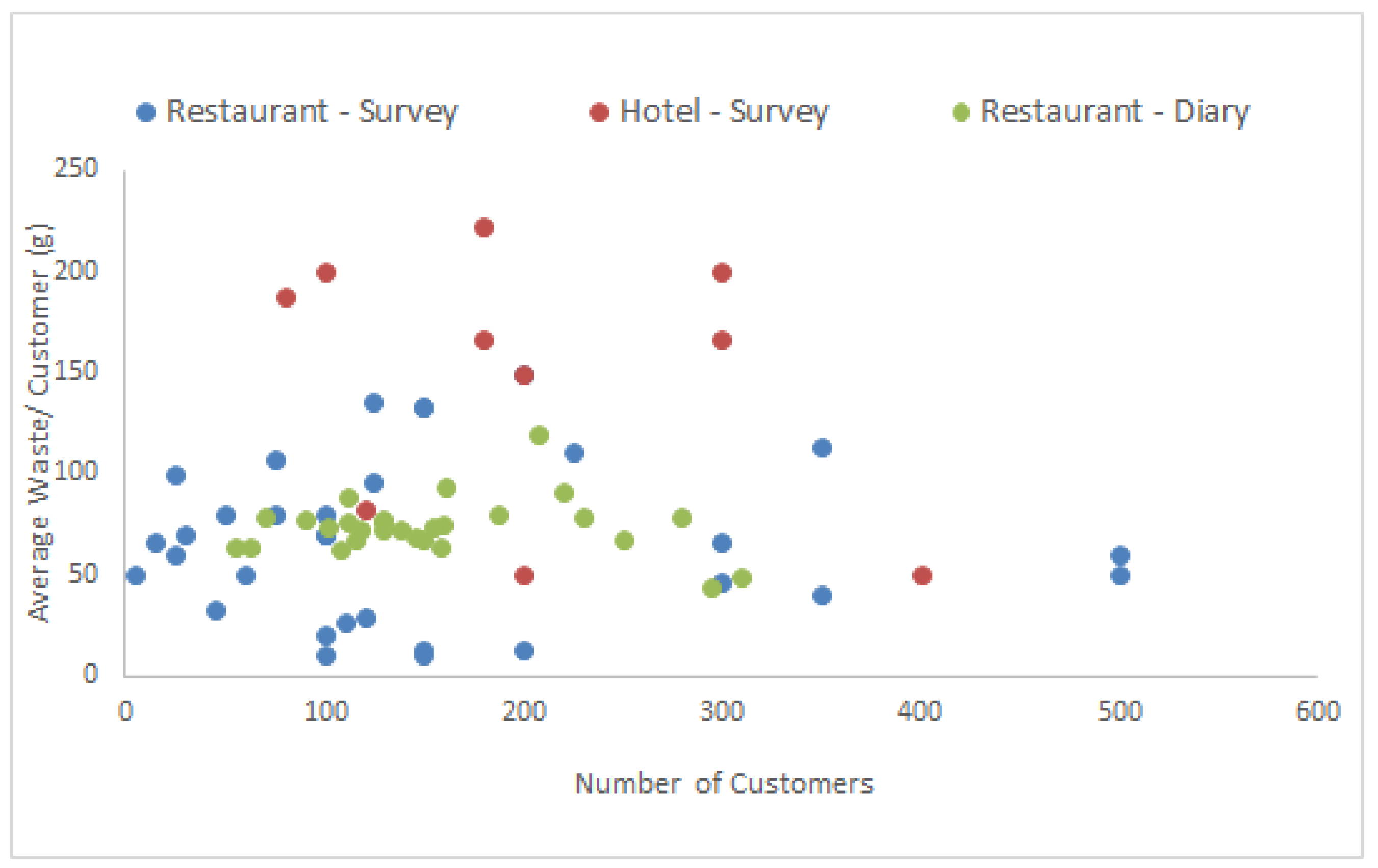
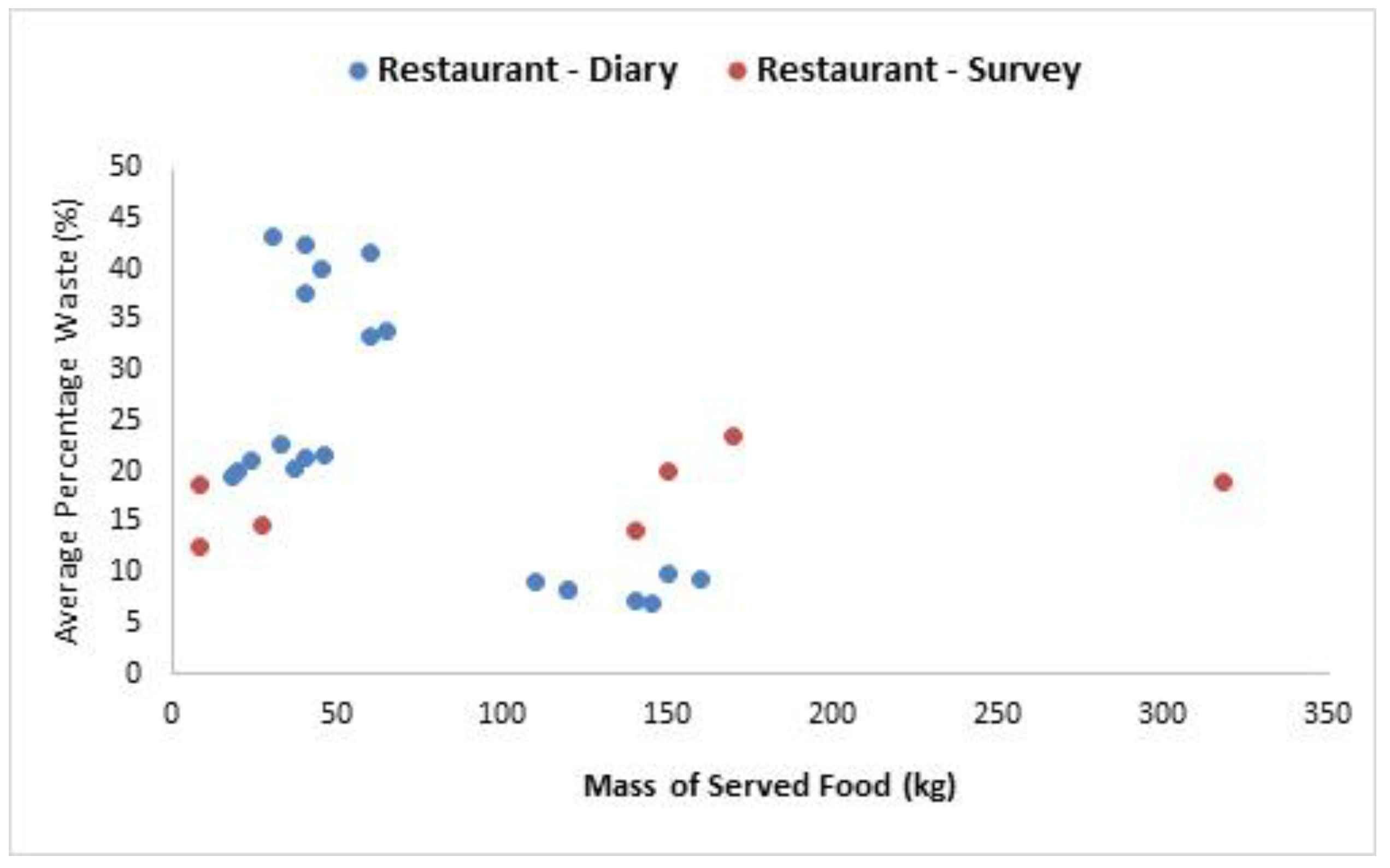

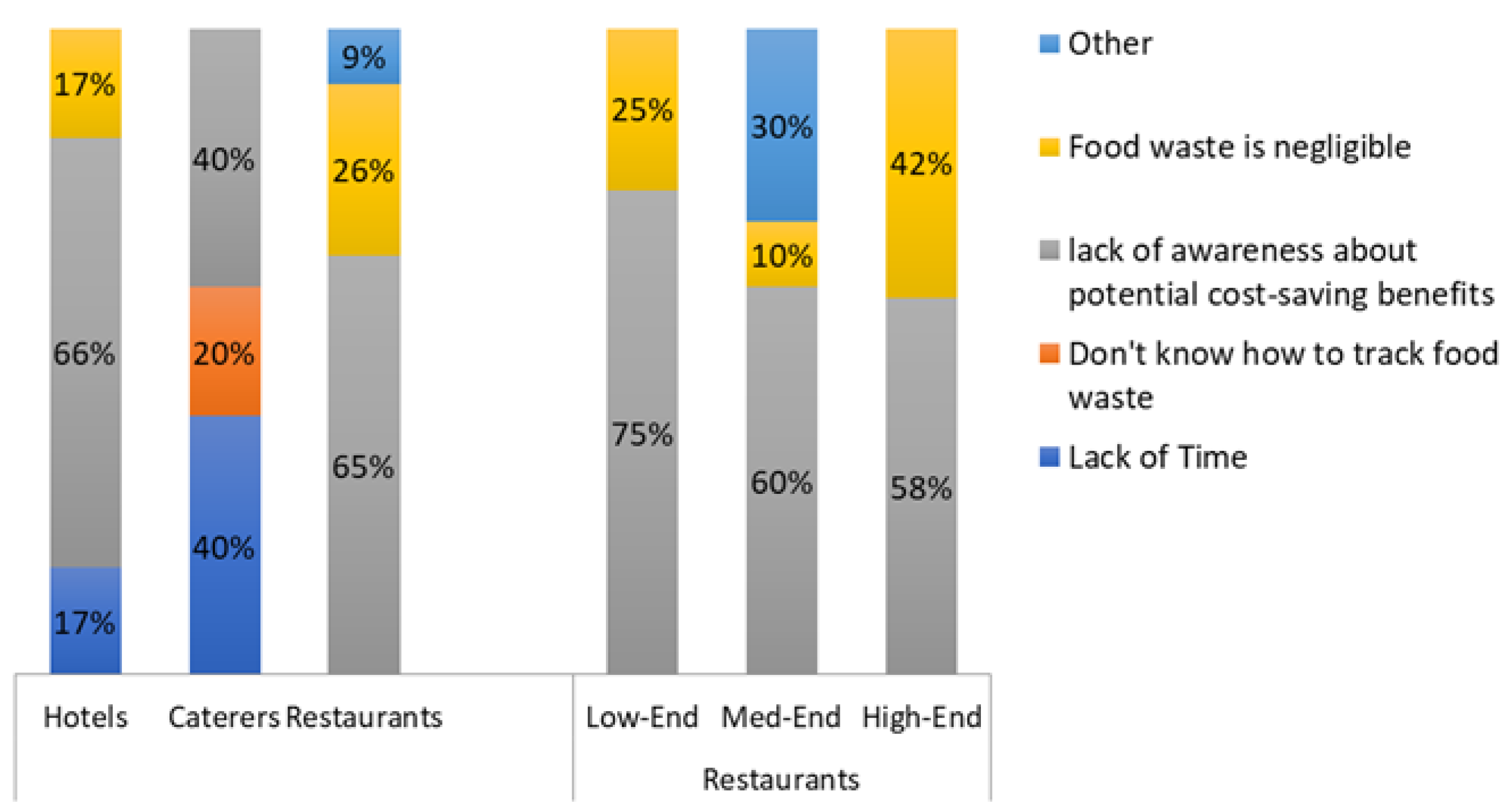
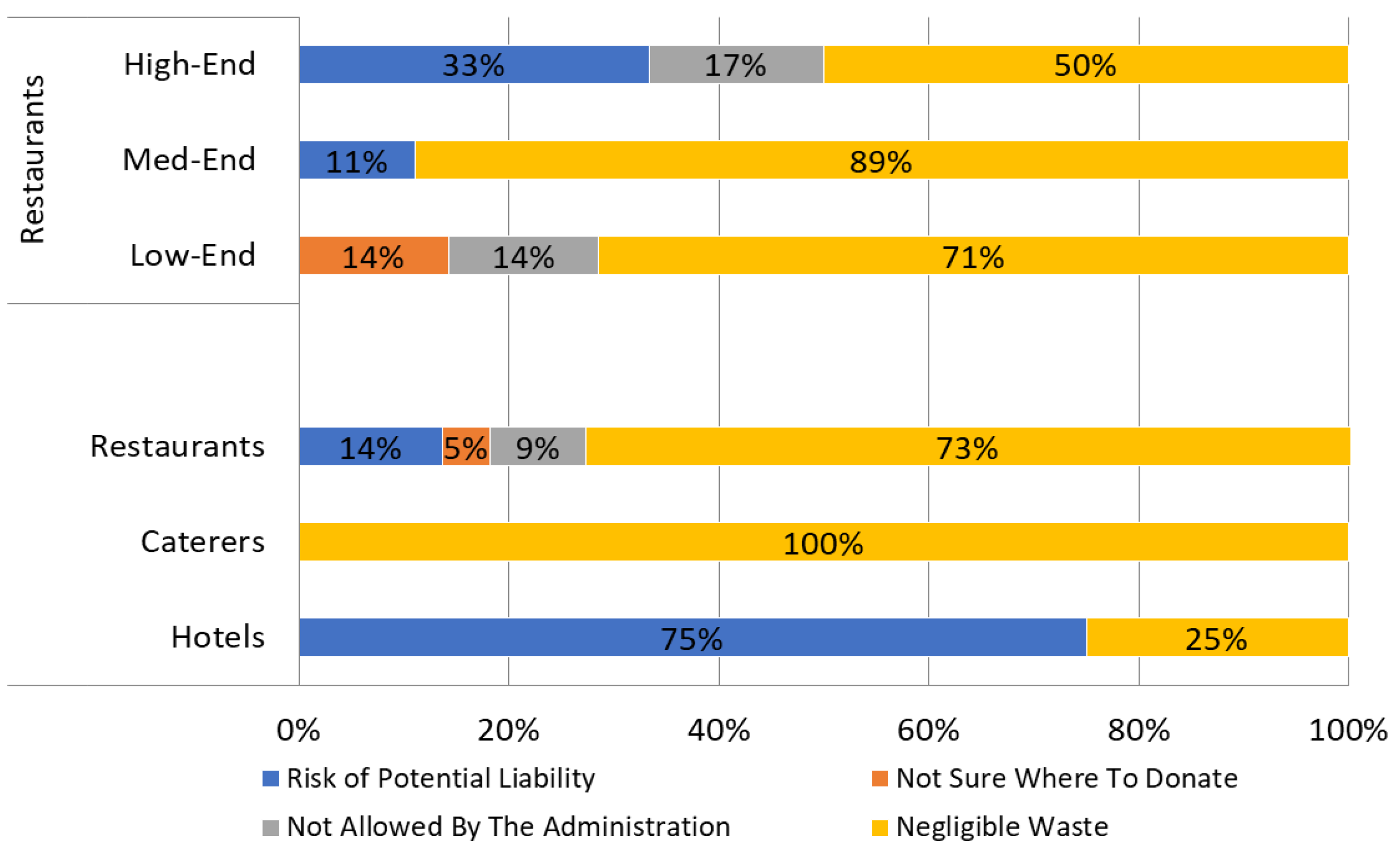
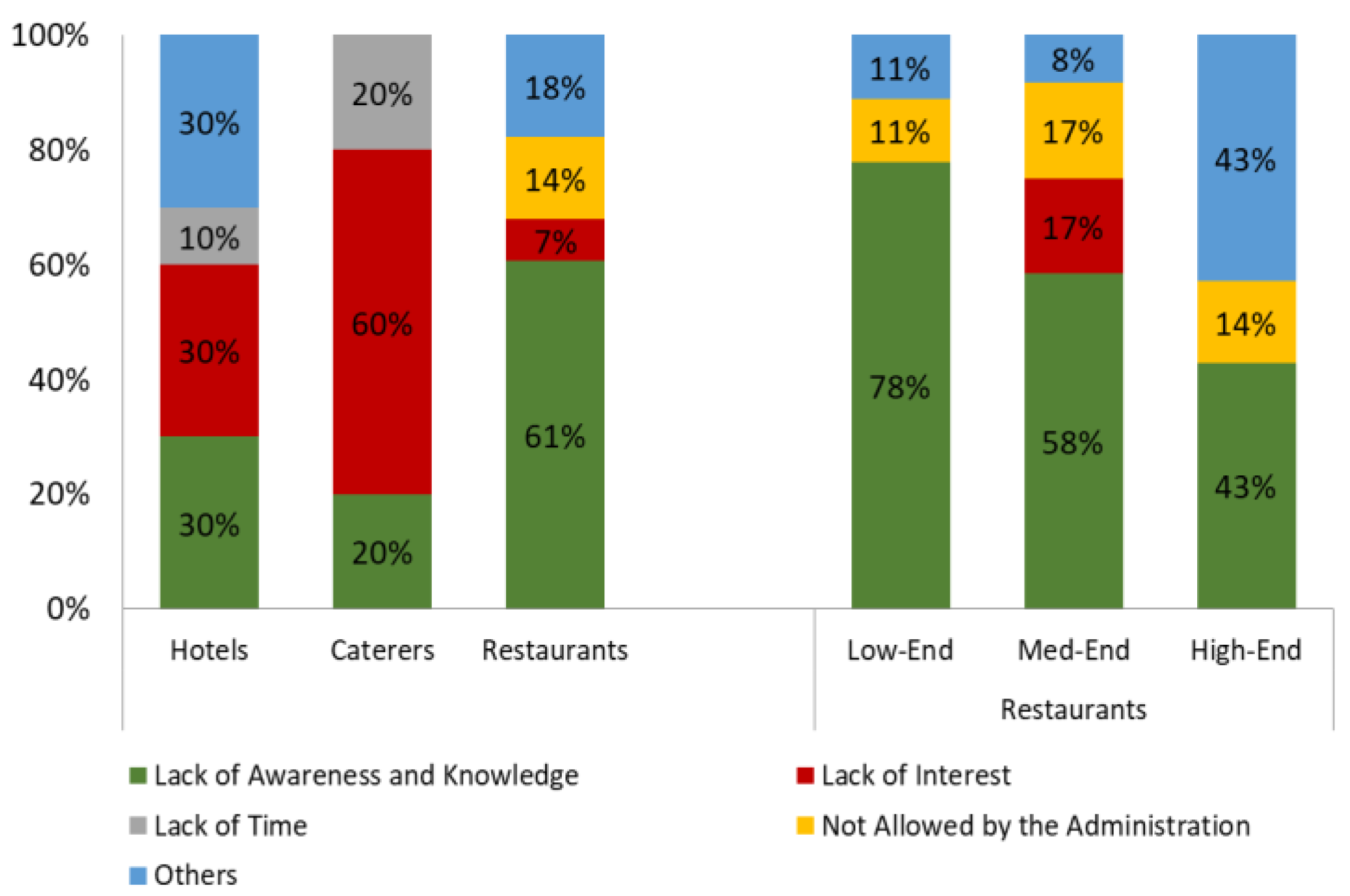
| Waste Per Customer/Day (g) | ||||||||
|---|---|---|---|---|---|---|---|---|
| Sector | Kitchen (n) | Amount of Waste (kg) | No. of Customer | No. of Days | Mean Waste per Customer (g) | Waste per Customer (g) | 95% Confidence Interval—Lower | 95% Confidence Interval—Higher |
| Surveys | ||||||||
| Restaurants | 32 | 392.25 | 5730 | - | 68 | 79 | 53.6 | 82.4 |
| Hotels | 10 | 285 | 2070 | - | 147.7 | 138.4 | 102.0 | 193.3 |
| Caterers | 11 | - | - | - | 140.9 | 140 | 92.1 | 189.7 |
| Live Tracking | ||||||||
| Restaurants | 4 | 321.8 | 4384 | 28 | 74 | 73.4 | 68.6 | 79.4 |
| Waste Per Customer/Day (g) | ||||||||
|---|---|---|---|---|---|---|---|---|
| Sector | Kitchen (n) | Number of Days | Items Procured (kg) | Amount of Waste | Mean Percentage (%) | Percentage Waste (%) | 95% Confidence Interval—Lower | 95% Confidence Interval—Higher |
| Surveys | ||||||||
| Restaurants | 7 | - | 811 | 156.5 | 17.7 | 15 | 14.0 | 21.5 |
| Live Tracking | ||||||||
| Restaurants | 3 | 21 | 1503 | 256 | 22.8 | 17.04 | 16.8 | 28.7 |
Publisher’s Note: MDPI stays neutral with regard to jurisdictional claims in published maps and institutional affiliations. |
© 2022 by the authors. Licensee MDPI, Basel, Switzerland. This article is an open access article distributed under the terms and conditions of the Creative Commons Attribution (CC BY) license (https://creativecommons.org/licenses/by/4.0/).
Share and Cite
Afzal, N.; Basit, A.; Daniel, A.; Ilyas, N.; Imran, A.; Awan, Z.A.; Papargyropoulou, E.; Stringer, L.C.; Hashem, M.; Alamri, S.; et al. Quantifying Food Waste in the Hospitality Sector and Exploring Its Underlying Reasons—A Case Study of Lahore, Pakistan. Sustainability 2022, 14, 6914. https://doi.org/10.3390/su14116914
Afzal N, Basit A, Daniel A, Ilyas N, Imran A, Awan ZA, Papargyropoulou E, Stringer LC, Hashem M, Alamri S, et al. Quantifying Food Waste in the Hospitality Sector and Exploring Its Underlying Reasons—A Case Study of Lahore, Pakistan. Sustainability. 2022; 14(11):6914. https://doi.org/10.3390/su14116914
Chicago/Turabian StyleAfzal, Nouman, Abdul Basit, Adil Daniel, Nausheen Ilyas, Asad Imran, Zoia Arshad Awan, Effie Papargyropoulou, Lindsay C. Stringer, Mohamed Hashem, Saad Alamri, and et al. 2022. "Quantifying Food Waste in the Hospitality Sector and Exploring Its Underlying Reasons—A Case Study of Lahore, Pakistan" Sustainability 14, no. 11: 6914. https://doi.org/10.3390/su14116914
APA StyleAfzal, N., Basit, A., Daniel, A., Ilyas, N., Imran, A., Awan, Z. A., Papargyropoulou, E., Stringer, L. C., Hashem, M., Alamri, S., Bashir, M. A., Li, Y., & Roy, N. (2022). Quantifying Food Waste in the Hospitality Sector and Exploring Its Underlying Reasons—A Case Study of Lahore, Pakistan. Sustainability, 14(11), 6914. https://doi.org/10.3390/su14116914









